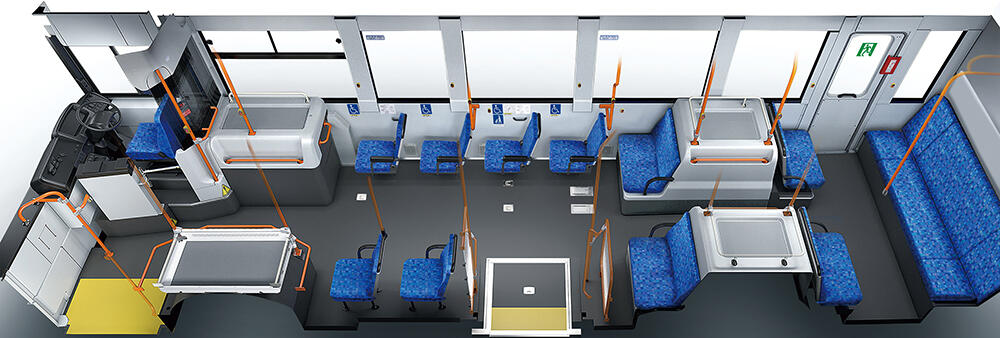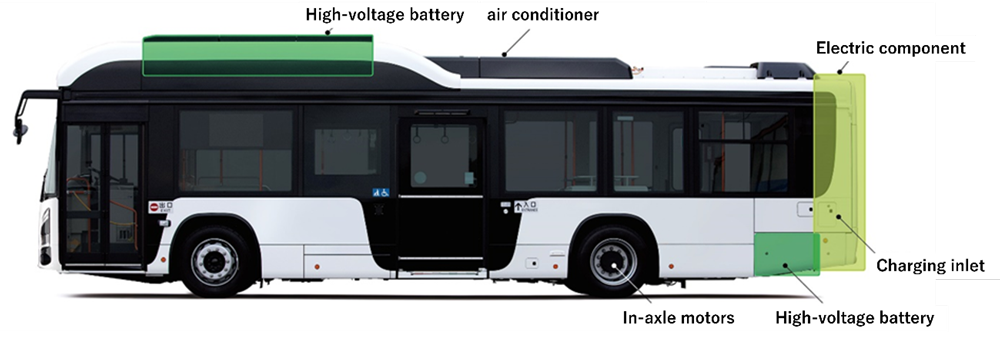Today marks the launch of the first in a series of battery-operated flat-floor route buses, named “ERGA EV,” by Isuzu Motors Limited (based in Yokohama, Kanagawa, Japan; Head of Operations: Shinsuke Minami). This groundbreaking bus, which premiered at the Japan Mobility Show 2023 in October-November last year, not only features zero-emission BEV technology but also boasts the distinction of being Japan’s first bus with a completely flat-floor design. The ERGA EV is poised to lead the charge in introducing next-generation buses in Japan, playing a pivotal role in steering the momentum towards achieving carbon neutrality in public transportation.
The fully flat-floor design enhances passenger convenience and comfort.
Innovative high-voltage battery layout
The “Green Growth Strategy Through Achieving Carbon Neutrality in 2050” introduced by the Japanese government emphasizes decarbonization efforts among bus operators. Isuzu believes that BEVs hold tremendous potential as a carbon-neutral power source for route buses operating primarily on fixed routes. Furthermore, there are high hopes for technologically advanced BEV route buses, especially with the upcoming 2025 Japan International Exposition (Osaka-Kansai Expo) slated to open in April next year. Drawing on its extensive product development experience, Isuzu has been actively designing a BEV route bus that considers passengers, drivers, and road conditions.
Key Features
ERGA EV’s lowered floor is made possible by the use of “in-axle motors,” where a motor is integrated into each side of the rear axle. By positioning the battery packs on the roof and under the floor at the rear of the vehicle, the accessible layout provides maximum flexibility, eliminating any steps from the front entrance to the back seat. This barrier-free design significantly enhances passenger convenience and safety, while the smooth acceleration of the BEV, combined with reduced noise and vibration levels, greatly enhances comfort.
The ERGA EV offers the same range as traditional route buses, delivering comparable performance to diesel engine models. It is equipped with a high-voltage battery that can be charged using Japan’s standard 350 V chargers and can be rapidly recharged from 20% to 80% in just 3.2 hours. In emergency situations, the ERGA EV can be linked to an external power source device that harnesses power from the vehicle to operate household appliances, showcasing its Vehicle to Load (V2L) functionality.
Enhanced Safety Features
For safety and driver comfort, the ERGA EV shares the same operability as conventional diesel models, featuring familiar gauges and controls around the driver’s seat, as well as creep capability. In terms of advanced safety measures, the ERGA EV stands out as the first route bus in Japan equipped with Driver Status Monitor (DSM) and Emergency Driving Stop System (EDSS), systems that detect driver irregularities and bring the vehicle to a safe stop, even on inclines. Furthermore, the bus incorporates a blind spot monitor to detect and alert the driver about pedestrians or cyclists next to the bus, aiding in accident prevention.
Advanced Connectivity
Setting a new standard in bus technology, the ERGA EV features Isuzu’s cutting-edge connected service, PREISM, enabling remote monitoring of the vehicle’s operational status. With PREISM, bus operators can oversee the battery’s state of charge (SOC) and driving range, offering new BEV bus operators the same level of assurance as in the past.
Operating BEV route buses necessitates the use of quick chargers, which may lead to increased electricity expenses due to heightened demand during peak hours. To address this issue, Isuzu’s operations management service has expanded functionalities for charging schedules and remote charging oversight, dovetailing with the bus operator’s energy management system. This service aids in minimizing electricity costs for bus operators by implementing charging schedules based on power generation forecasts.
Aligned with the company’s mission, “Moving the World—for You,” Isuzu remains steadfast in providing solutions to the challenges confronting customers, society, and all stakeholders, forging a brighter future.
*1 Driving range may vary depending on factors such as external temperature, usage of air conditioning, and passenger occupancy.
*2 Quick charging (CHAdeMO) at an external temperature of 20°C with a 50 kW charge output.
*3 Vehicle to Load. Compatible with the prevailing standard in Japan (EVPS-004: 2014).
*4 Driver Status Monitor
*5 Emergency Driving Stop System
*6 State of Charge. Indicates the remaining charge in the battery.
<ERGA EV short wheelbase urban model, main specifications>
| Type | ZAC-LV828L1 |
|---|---|
| Length × width × height | 10,545 mm × 2,485 mm × 3,330 mm |
| Wheelbase | 4,990 mm |
| Motor type | AC induction motor |
| Maximum output / Maximum torque | 250 kW (125 × 2) / 960 N·m (480 × 2) |
| Battery type | Lithium-ion battery |
| Battery capacity | 245.3 kWh (internal reference value) |
| Charging method | Quick charging (CHAdeMO) |
| Driving range per charge | 360 km (constant speed of 30 km/h, value reported to the Ministry of Land, Infrastructure, Transport and Tourism) |
| Minimum turning radius | 7.8 m |
| Seating capacity | 70 passengers |
<Target sales volume>
150 units/year
<Suggested retail price in Tokyo area>
Type ZAC-LV828L1
59,801,800 yen (65,781,980 yen including consumption tax)
SOURCE: Isuzu
[ad_2]


